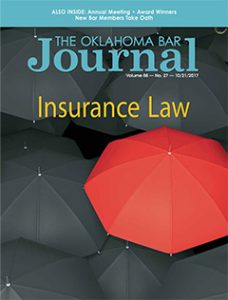Oklahoma Bar Journal
October 2017 | Insurance Law

Feature Articles
Oklahoma's Uninsured Motorist Coverage Statute - An Overview
This article discusses the current version of Oklahoma’s Uninsured Motorist Coverage Statute, 36 O.S. §3636 (the statute).1, 2 Many of the subsections of the statute discussed below could easily be the subject of independent articles, as the case law discussing uninsured/underinsured motorist (UM) coverage3 – as well as the statute itself – is constantly evolving. As such, this article provides only a cursory discussion of the statute and select cases discussing same.
Insurance Risk Management Considerations in Indian Country
While on the campaign trail in August of 2004, President George W. Bush attended the UNITY Conference, a convention of diverse journalists. He was asked by Mark Trahant, former president of the Native American Journalists Association, to comment on tribal sovereignty. He said, “Tribal sovereignty means that. It’s sovereign. You’re a ... you’re a ... you’ve been given sovereignty and you’re viewed as a sovereign entity.”1 Aside from the misnomer that tribes were “given” sovereignty – a distinction that rightfully caused a firestorm of criticism from Indian country2 – the president’s response exemplified that tribal sovereignty is often not well-understood.
'Fines or Penalties' Exclusions in Professional Liability Policies
Professional liability insurers have, with varying degrees of success, denied coverage for sanctions imposed against their insured under “fines or penalties” exclusions (FP exclusions) in professional liability policies. There are no Oklahoma or 10th Circuit cases discussing FP exclusions in the context of sanctions and scant case law from other jurisdictions addressing the issue. This article 1) explains FP exclusions in professional liability policies; 2) summarizes relevant case law from other jurisdictions; and 3) analyzes whether various types of discovery sanctions imposed pursuant to Section 3237 of the Oklahoma Discovery Code are likely to be excludable under an FP exclusion.
Ethical Issues in Insurance Law
For attorneys who practice the law of insurance, complex and difficult-to-resolve ethical issues are abundant. Conflicts of interest, issue conflicts, confidentiality dilemmas and insurers’ measures to control litigation costs are regular occurrences that attorneys must resolve. In an environment where attorneys are increasingly the target of dissatisfied litigants, vigilance in complying with the Rules of Professional Conduct and the overall integrity of the profession are not only an ethical obligation, but are necessary to protect the attorney from liability claims by the insured or insurer. These issues arise most often in the relationship where attorneys are hired by insurers to defend insureds, and much of this article is so focused. However, many of the issues create conundrums in first-party insurance relationships as well. This article surveys some of the recurring attorney ethical and liability issues in both relationships.
Some Considerations in Insuring Against Cyber Loss
The purpose of any insurance policy is to manage or transfer the risk of unfavorable occurrences away from the insured. For millennia, insurance policies have existed to transfer the risk of hazards which cause damage to property. For centuries,policies have existed to transfer the risk of injuries or damages arising from individuals’ negligent acts.
Discovery in ERISA: The Exception, Not the Rule
The Employee Retirement Income Security Act of 1974 (ERISA) set minimum federal standards for employer-sponsored retirement, health and other welfare benefit plans.1 Although ERISA does not apply to all employer-provided benefit plans, when it does apply, the plan and claim administrators must ad-here to “various uniform procedural standards concerning reporting, disclosure, and fiduciary responsibility.”2 An ERISA participant or beneficiary who believes these standards have not been met may bring a civil action to enforce or determine his rights under the plan. 3
